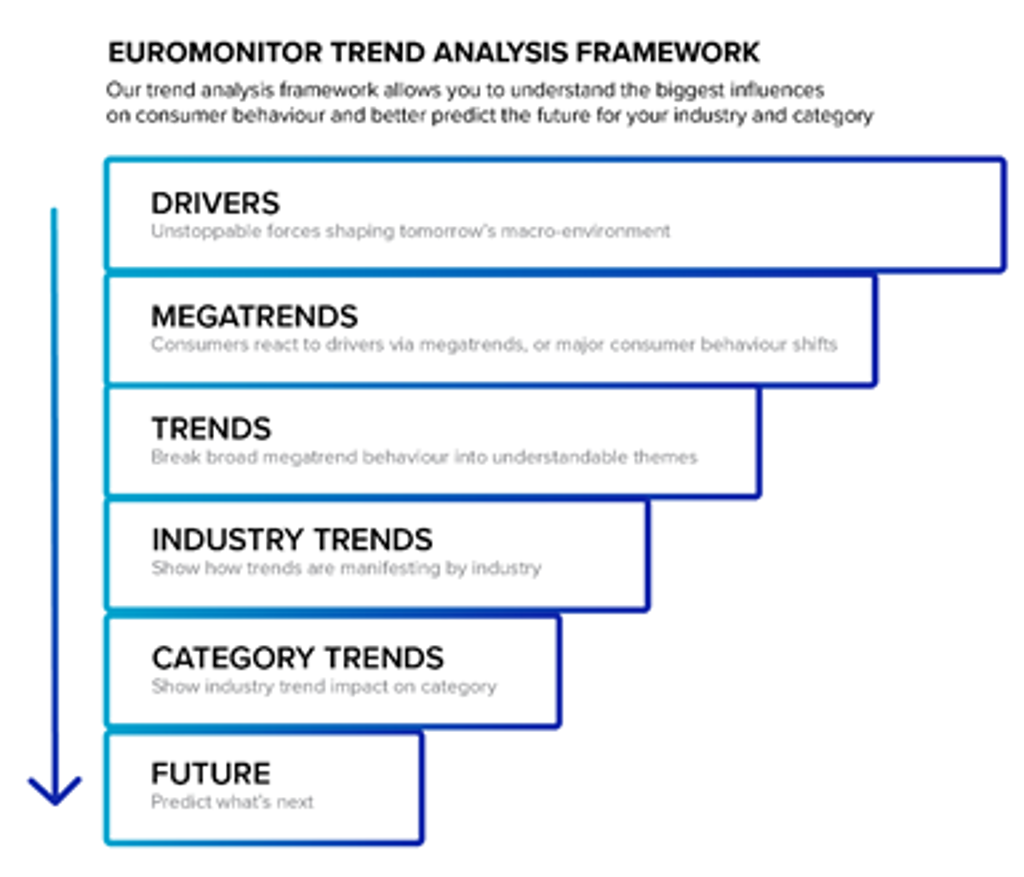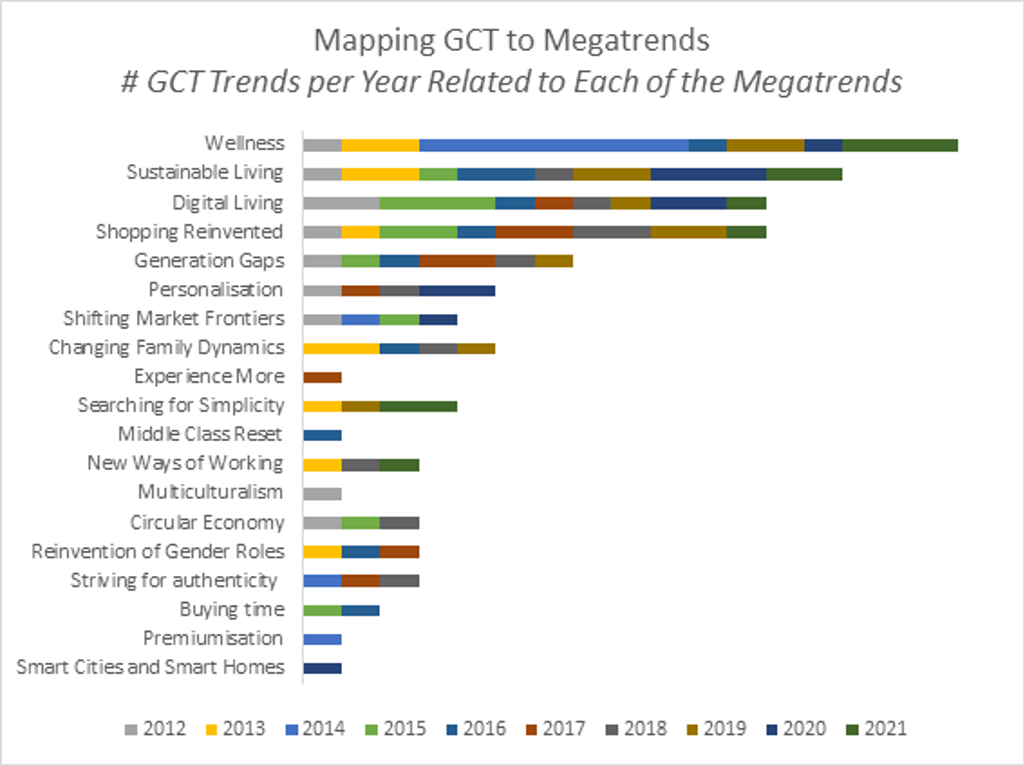Euromonitor International has an established framework through which we evaluate both long-term megatrends and the annual global consumer trends which influence business in the year ahead. These trends show how consumer values and purchasing decisions are shifting, and the impact these have on industries, categories and new product development.

As we step away from a tumultuous 2020/21, and begin to consider what the future holds, it is important to focus on the key predictors of consumer purchasing decisions, or what is here to stay. To achieve this, we have overlayed the top 10 Global Consumer Trends (GCT) against the Megatrends to understand the evolution of consumer behaviour.

Here are the three leading trends that we have gained from this study:
- Wellness and Sustainability have been at the top of the agenda for consumers for the last decade, but from parallel analysis in our Quantifying Megatrends model, we know that these are still some of the lowest in terms of share of spend.
- Digital Living is a key enabler for consumers to easily connect with brands and create experiences; this has been significantly accelerated in 2021 as highlighted in the 2021 Global Consumer Trend: Phygital Reality.
- Shopping Reinvented and the shift from a transactional purchase to a consumer journey with many touchpoints is redefining how products are being taken to market as discussed in Euromonitor International’s briefing ‘Commerce 2040: The Reinvention of Retail for a Digital World’
With deeper analysis to evaluate what Global Consumer Trends have emerged under the key Megatrends in the past decade, we are able to paint an interesting picture of what is to come:
Wellness: From a diet and weight focus to an all-encompassing holistic health by 2020
Tracking Global Consumer Trends on wellness, the evolution from a focus on diet and exercise 10 years ago to a holistic approach to health encompassing physical, mental and spiritual wellness is evident today.
Wellbeing started to hit the headlines in 2010 as a key goal for governments, especially targeting obesity and weight issues. Consumers paid attention and by 2013/14 demand for probiotics and natural food and beverages had started to take off, as did vegetarianism as a healthy lifestyle rather than just an ethical choice.
In later years, mental health has become the focus, driven by younger consumers, millennials and now Generation Z. Since the arrival of the COVID-19 pandemic, the wellness megatrend has accelerated even further as consumers focus on both their physical and mental safety.
We anticipate that GCT related to wellness will continue to manifest, particularly as the world emerges from the pandemic with heightened awareness of preventative health and mental wellbeing.
Sustainable Living: A rapid shift from small steps to activism and responsible choices
Our GCT shows consumers’ growing interest in environmental and sustainable issues over the years. Analysing the GCT associated with Sustainable Living, 7-10 years ago, consumers, predominantly millennials, started making greener choices and having more of a voice on social media. Within a few years, this had evolved into a real focus on cleaner living and cruelty-free where veganism and rejecting alcohol and tobacco were top of the agenda and consumers were making more resourceful choices such as renting and sharing goods and services. Consumer voices also strengthened, especially in relation to important environmental and social issues. Calling companies out and boycotting brands that do not agree with an individual’s sustainable values became the norm.
In recent years, GCT showed consumers’ sustainability attention developing further to centre on major environmental issues from reducing plastic use to pollution and climate action in addition to becoming more socially responsible.
With companies across the board setting sustainability at the top of their strategic priorities, we anticipate that consumers will increasingly veer their spending towards those that are succeeding to deliver a positive impact on people and the planet.
Digital Living: Consumers rapidly adapting to digital living as benefits outweigh concerns
Looking back to 2011/12 Global Consumer Trends, we see a rise in the mobile-first era with trends such as “Mobile & Online” and “Smartphone Universe” making it into the top 10. Consumers were craving information and connected living evolved rapidly.
Despite this, trends have also evolved around consumers concerns regarding privacy and security as their digital lives developed, especially in recent years as advanced technology such as augmented and virtual reality, and artificial intelligence have gained momentum. For most however, convenience trends have outweighed these concerns with consumers embracing personalisation, e-commerce and online engagement, as evidenced with Global Consumer Trends such as “View in my Roomers” in 2018, “Digitally Together in 2019” and in 2021, “Phygital Reality”.
Globally, consumers have accepted and adapted to this shift online and as technology advances continue at a rapid pace, digital living trends will remain dominant within GCT moving forward.
Shopping Reinvented: Consumers increasingly expect more from the shopping experience
Consumer comfort with shopping online and their desire, especially from millennials and now Generation Z, to be able to shop anywhere at anytime, has fuelled increasing shifts in how and where consumers shop.
GCT shows the evolution of shopping from a transactional purchase to multi-sensory and engaging shopping journeys in-store or online, across platforms and touchpoints, where the customer is centre-stage and in control. Early Global Consumer Trends highlighted the rising importance of “reality culture” - where millennials shared purchase and shopping information on social media - and “influencers”. Over the review period, we have seen a greater focus on pre-shopping research evolving to show how consumers have become experts regarding their planned purchases and are demanding more, from faster deliveries and more convenient ways of shopping, to post-purchase services and obtaining greater value from their purchases.
Consumers are in control and demanding more. Value and convenience trends will continue to play a key role within Global Consumer Trends in the future.
Why is this important to business?
By assessing GCT over time we can look for patterns of how consumer behaviour and priorities are shifting. It also allows us to see the evolution of long-term Megatrends and provides insight on future shifts to inform strategy planning.
With this assessment in hand, we can confidently determine which are the prevalent long-term trends that will shape consumer purchasing decisions, and hence guide innovation and investment strategies to ensure that future portfolios speak directly to those consumer needs.
